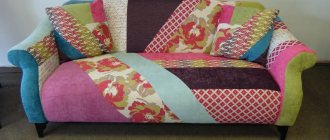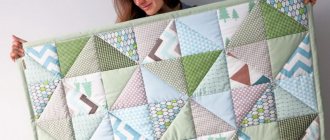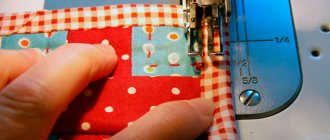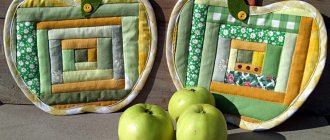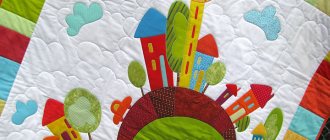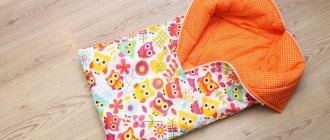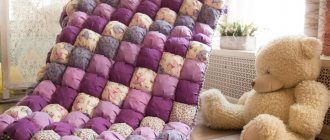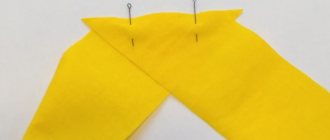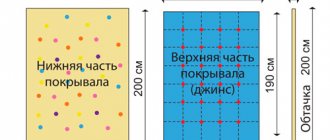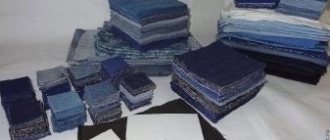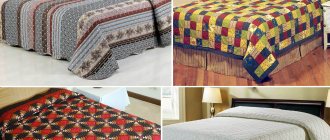Previously, products using the patchwork technique were in almost every home. But even now they are no less popular. A blanket or bedspread made from multi-colored scraps is often used to decorate an interior in Provence or country style. But the finished product is quite expensive. To avoid unnecessary expenses, you can create a patchwork quilt with your own hands. In addition, the patchwork technique is not as complicated as it might seem. Handicraft masters can sew real masterpieces from scraps of fabric. But for beginners in this business, it is better to first learn the basic rules of working with fabric and use ready-made templates.
…
How to sew a patchwork quilt
Sewing patchwork quilts with your own hands is a very interesting activity that is fascinating and takes a lot of time. The main thing is that to make such things you can use old fabrics or things that you haven’t worn for a long time. Therefore, blankets made from scraps are comparatively cheaper than those purchased from a factory.
If you don’t have any old items, you can buy scraps of fabric at the store or use patchwork kits on sale. When creating a patchwork quilt with your own hands, patterns can be easily found on the Internet, and from their description, it is clear that they recommend choosing at least 6 different colors of fabric.
Sewing help:
Choosing filling for a quilt
Since the products are different, the filler required is different. They consist of at least 2-3 layers:
- Beautifully designed top.
- Filler or, as it is commonly called, insulation.
- The bottom part of the blanket is called the lining.
It is worth noting that if you create a patchwork quilt with your own hands without a second layer, you will get a very beautiful bedspread. Most often, it is customary to use synthetic winterizer as a filler or insulation. This material does not shrink or deform after exposure to water. And this quality is perfect for creating things using the patchwork technique. But if you want to sew a baby blanket for a newborn, then it is better to resort to using only natural materials in production. Here are a few natural-based fillers for sewing a quilt:
- You can use cotton-based insulation. When using such natural material, pay attention to the fact that the blanket may shrink after washing, so stretch the insulation before sewing it into the product. The color of such filler is most often milky, and the thickness is no more than 3-4 cm.
- Natural wool filler has a composition of 100% natural fiber. Very light and weightless material, retains heat perfectly, and is ideal for sewing children's blankets.
Patchwork bedspread in a modern interior 61 photos
Examples of original ideas can be seen in the photographs. Here are bedspreads made in patchwork style that fit perfectly into the style of the home. Products can be cotton, cotton and others. The color should “echo” the main color chosen for the design of the room.
Handmade things retain the warmth of the craftswoman. The tutorial above shows that even something as large as a bedspread is easy to make. The only thing a beginner may lack in the process is patience.
Author: Galina Kanashchuk
Tools and materials for sewing a quilt
The patchwork technique is becoming very popular these days. More and more specialized sewing stores are offering patch sewing kits and patterns for free sale. But you can also assemble all the equipment yourself, because many tools are found in every home’s sewing drawer. In order to start practicing this needlework technique, you will need to stock up on this list of necessary tools and materials:
- Well-sharpened scissors or a quilting knife.
- Sewing needles.
- Threads.
- A simple pencil.
- Tailor pins.
- Measuring tape in centimeters.
- Tailor chalk or soap.
- Paper.
- Sewing machine.
- Material for flaps.
- Natural insulation for blankets.
- Lining.
Patchwork baby quilt:
DIY baby quilt for girls
Products using this technique can be created for both girls and boys; all you need to do is simply change the color of the fabric. For a girl, use the desired pink shades of cotton fabrics and use natural insulation as a filler.
When creating a patchwork quilt, you can watch a master class for beginners on the Internet to get a rough idea of what kind of work you have to do. As it became clear from the video, novice needlewomen often use the chess patchwork technique.
Patch blanket for a girl
Materials for production:
- scissors;
- threads;
- fabric in two shades of pink;
- paper;
- pencil.
Take paper and draw a diagram according to which we will cut and sew the product. As a rule, a small square patchwork blanket measuring 120 by 120 cm is sewn for children. Cut out a square from the paper you will use to cut it. Using the diagram, count how many squares of different fabrics you will need and start cutting.
After cutting the fabric, distribute the flaps in a checkerboard pattern. And start sewing the pieces of fabric together, ironing each seam from the inside with an iron and steam. As soon as the top fabric is ready, iron it properly and begin basting the insulation. Distribute the batting or wool over the surface of the product and baste it by hand, it will be more convenient, then sew on a sewing machine so that the fabric does not bunch up.
Quilt the blanket along with the insulation along the existing seams from the flaps. Sew each square, this will allow the insulation not to bunch up and keep its shape during use.
From one solid piece of material, cut out the lining for the bottom of the baby blanket. And also baste and stitch on the machine, three sides and half of the fourth. Carefully turn and hand stitch the remaining portion of the quilt.
Photo gallery:
Dimensions
Since it is understandably difficult to make a bed for a blanket or to fit it to it, the blanket is sewn to the size of the bed. If your bed(s) are factory purchased, then blankets of one of the following sizes will fit it/them:
- Euro – 210x200 or 200x200 cm.
- Double, depending on the height and build of the couple - 210x180 (small skinny ones), 215x175 (plump short ones), 200x200 (average height and build), 220x240 (large ones).
- Single beds - 215x155 or 205x150.
- Single – 200x150.
- Children's - 150x120 (predominantly for boys) or 140x110 (more girlish).
- For newborns - the size of the changing table plus 12-15 cm in each direction. Typical size 120x120 cm.
The dimensions of the blanket for the existing bed are selected so that its edges (fringe, lace, frill, ruffle) on a made bed without lying down do not reach the floor by 12-15 cm, otherwise the edge of the blanket will get dirty. Also, the blanket on a free bed should not bunch up at the feet or heads, otherwise the insulation will creep. The size of the blanket determines the amount of materials needed for sewing.
Patchwork baby blanket using the well technique
When creating patchwork quilts with your own hands, photos of sample works can be viewed on the Internet. When you see a product made using the technique of joining flaps called a well, you definitely won’t be able to pass it by. Remember the main rule for sewing - when sewing, the scraps should go to the side precisely from the center of the product. Thus, the correct visual effect is created.
It is best to take larger shreds, or rather, not huge, but long. It would be better to say that it has a regular rectangular elongated shape.
Step-by-step instructions for patchwork sewing such a product look like this:
- Take a sheet of plain paper or whatman paper is much better, and draw a pattern for patchwork sewing with your dimensions.
- Each element is drawn in full size on separate sheets.
- Lay out all the stencils that will be used to cut out the flaps on the fabrics; for sewing using this technique, it is best not to overdo it with the number of colors - two quite contrasting colors will be enough. We add about 1 cm of allowance to each piece to sew the parts together.
- After cutting out the elements is completed, we recommend laying out the entire drawing from them together to see what happens and whether you did everything correctly. For patchwork sewing, take cotton-based fabric, and, of course, the same texture.
- Baste the parts together and iron them properly, so that later it will be easier to sew on a sewing machine.
- Connect all the squares of the structure together using a sewing machine, press all the seams on the inside.
- Now add a second layer of insulation inside and stitch it along the existing seams on the blanket.
- Then we cut the back side out of the lining material and sew it to the product.
Baby patchwork quilt:
Quilting (firmware)
- Place the stitch through all layers of the product. Be sure to make a knot at the end of the quilting thread. Don't forget to put a thimble on your finger.
- Place the hoop in the central part of the blanket and gradually move towards the edges of the work, while making sure that all layers are equally stretched.
- Insert a needle into the top part of the blanket (about two centimeters from the beginning of the product). Pull the thread slowly until the knot reaches the middle of the pad through the fabric. After this, make a small stitch “by the needle”, then another one. Continue, making sure that the thread covers all three layers of the future blanket, and the stitches themselves are neat.
